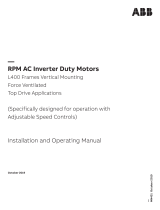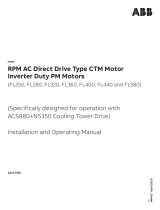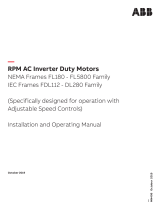
6
LV Motors/Machine Instructions 10-2000
Maintenance and lubrication
General inspection
- Inspect the machine at regular intervals.
- Keep the machine clean and ensure free
ventilation airflow.
- Check the condition of shaft seals (eg V-ring) and
replace if necessary.
- Check the condition of connections and mounting
and assembly bolts.
- Check the bearing condition by listening for
unusual noise, vibration measurement, bearing
temperature, inspection of spent grease or SPM
bearing monitoring.
* When changes of condition occur,
dismantle the machine, check the parts
and replace if necessary.
Lubrication
Machines with permanently greased bearings
Machines up to frame size 180 are normally fitted with
permanently greased bearings of either Z or 2Z types.
Bearing types are specified in the respective product
catalogues and on the rating plate of each motor from
size 112 and larger.
As a guide, adequate lubrication can be achieved for the
following duration, according to L1 at ambient
temperature of 25° C.
32 000 - 45 000 duty hours for 4 pole machines.
1)
16 000 - 26 000 duty hours for 2 and 2/4 pole
machines.
1)
The shorter times apply to larger frame sizes.
1)
Depending on application and load conditions, see
applicable product catalogue.
Hours of operation for vertical motors are half of the
above values.
Machines with relubrication system
WARNING
Beware of all rotating parts!
Relubrication procedure:
- Remove grease outlet plug if fitted.
- Press fresh grease into the bearing until all old grease
has been forced out
- Let the motor run 1-2 hours to ensure that all excess
grease is forced out of the bearing. Close the grease
outlet plug if fitted.
Regrease motors while running. If this is not possible,
lubrication can be carried out while the machine is at a
standstill. In this case, use only half the quantity of
grease, then run the motor for a few minutes at full
speed. When the motor has stopped, the remaining
quantity of grease can be forced in until the old grease
has been replaced.
After 1-2 running hours close the grease outlet plug (if
fitted).
The grease outlet plug must be removed permanently
with automatic lubrication.
If the machine is fitted with a lubrication information
plate, follow the given values, otherwise use the values
in table below.
ABB Motors policy is to have reliability as a vital issue
in bearing lubrication intervals. That is why we follow the
L1-principle (meaning that 99 % of the motors are sure
to make the interval time). According to L1 policy the
lubrication intervals are as follows:
Frame Amount 3600 3000 1800 1500 1000 500-900
size of grease r/min r/min r/min r/min r/min r/min
g/bearing
Ball bearings
Lubrication intervals in duty hours
112 10 10000 13000 18000 21000 25000 28000
132 15 9000 11000 17000 19000 23000 26500
160 25 7000 9500 14000 17000 21000 24000
180 30 6000 8000 13500 16000 20000 23000
200 40 4000 6000 11000 13000 17000 21000
225 50 3000 5000 10000 12500 16500 20000
250 60 2500 4000 9000 11500 15000 18000
280 70 2000 3500 8000 10500 14000 17000
315 90 2000 3500 6500 8500 12500 16000
355 120 1200 2000 4200 6000 10000 13000
400 120 1200 2000 4200 6000 10000 13000
Roller bearings
Lubrication intervals in duty hours
160 25 3500 4500 7000 8500 10500 12000
180 30 3000 4000 7000 8000 10000 11500
200 40 2000 3000 5500 6500 8500 10500
225 50 1500 2500 5000 6000 8000 10000
250 60 1300 2000 4500 5700 7500 9000
280 70 1000 1700 4000 5300 7000 8500
315 90 1000 1700 3300 4300 6000 8000
355 120 400 1000 2000 3000 5000 6500
400 120 400 1000 2000 3000 5000 6500
Lubrication intervals for vertical machines are half of the
above values.
The amount of grease stated in the table should be
doubled if an automatic regreasing system is used.
The table values are based on the motor running at rated
output in an ambient temperature of about + 25° (approx.
80°C bearing temperature). The values should be halved
for 15°C increase in bearing temperature and may be
doubled for 15°C decrease in ambient temperature.
WARNING
The maximum operating temperature of the
grease and bearings must not be exceeded.
Higher speed operation, eg in frequency converter
applications, or lower speed with heavy load will require
shorter lubrication intervals. Consult ABB Sales Office in
such cases.
Typically a doubling of speed will require a reduction of
lubrication intervals to approx. 40 % of values tabulated
above.
Suitability of bearings for high speed operation must be
checked.
















